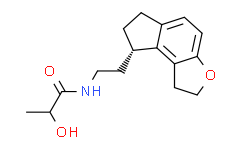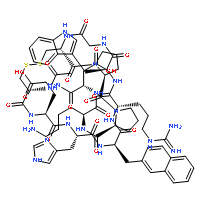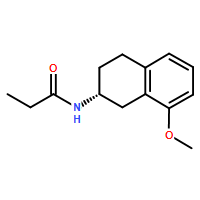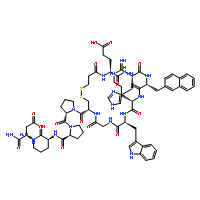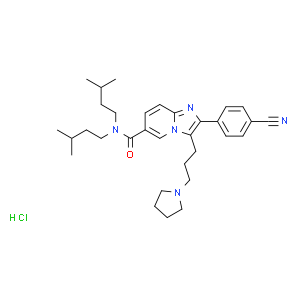| 中文名称: | Ramelteon metabolite M-II | ||||
|---|---|---|---|---|---|
| 英文名称: | Ramelteon metabolite M-II | ||||
| 别名: | 2-羟基-N-{2-[(8S)-1,6,7,8-四氢-2H-茚并[5,4-b]呋喃-8-基]乙基}丙酰胺;雷美替胺的代谢产物M- II标准品 DES(1-oxopropyl)-2-hydroxy-1-oxopropyl-ramelteon | ||||
| CAS No: | 896736-21-3 | 分子式: | C16H21NO3 | 分子量: | 275.34 |
| CAS No: | 896736-21-3 | ||||
| 分子式: | C16H21NO3 | ||||
| 分子量: | 275.34 | ||||
基本信息
|
产品编号: |
R10498 |
||||
|
产品名称: |
Ramelteon metabolite M-II |
||||
|
CAS: |
896736-21-3 |
储存条件 |
粉末 |
-20℃ |
四年 |
|
分子式: |
溶于液体 |
-80℃ |
二年 |
||
|
分子量: |
275.34 |
|
|
||
|
化学名: |
2-hydroxy-N-[2-[(8S)-2,6,7,8-tetrahydro-1H-cyclopenta[e][1]benzofuran-8-yl]ethyl]propanamide |
||||
|
Solubility (25°C): |
|||||
|
体外:
|
DMSO |
|
|||
|
Ethanol |
|
||||
|
Water |
|
||||
|
体内(现配现用): |
|
||||
|
<1mg/ml表示微溶或不溶。 |
|||||
|
普西唐提供的所有化合物浓度为内部测试所得,实际溶液度可能与公布值有所偏差,属于正常的批间细微差异现象。 |
|||||
|
请根据产品在不同溶剂中的溶解度选择合适的溶剂配制储备液;⼀旦配成溶液,请分装保存,避免反复冻融造成的产品失效。 |
|||||
生物活性
|
产品描述 |
雷美替胺 (Ramelteon) 的主要代谢物,其对人褪黑素受体 1和2 的 IC50 值分别为 208pM 和 1470pM。雷美替胺是褪黑素受体 (melatonin) 的选择性激动剂。 |
|
靶点 |
Melatonin Receptor |
|
体外研究 |
The affinity of Ramelteon metabolite M-II (M-II) for MT1 receptors is 10-and 2.5-fold lower than that of ramelteon and melatonin,respectively.Likewise, the affinity of M-II for MT2 receptors is approximately 5-and 1.5-fold lower than that of ramelteon and melatonin,respectively.Ramelteon metabolite M-II exhibits no affinity for quinone reductase 2 at concentrations up to 10μM.Moreover,the selectivity of Ramelteon metabolite M-II for melatonin receptors relative to 215 targets including other receptors,transporters,ion channels and enzymes is investigated.Ramelteon metabolite M-II shows no significant affinities and activities for the other targets,except for the 5-HT2B receptor,for which the Ki value was 1.75±0.23μM.The potency of Ramelteon metabolite M-II for MT1 receptors is approximately 17-and 4.3-fold lower than that of ramelteon and melatonin,respectively.Similarly,the potency of Ramelteon metabolite M-II for MT2 receptors is approximately 28- and 1.6-fold lower than that of ramelteon and melatonin,respectively. |
|
体内研究 |
Ramelteon metabolite M-II (1mg/kg) significantly increases NREM sleep (F1,7=96.3,p<0.01) and significantly decreases wakefulness (F1,7=56.7,p<0.01).Moreover,a lower dose of M-II (0.1mg/kg) yield similar results (NREM, F1,7=121.9,p<0.01;wakefulness,F1,7=87.0,p<0.01),and decreased wakefulness is sustained for 6h after the administration of either dose.After the administration of 0.01mg/kg Ramelteon metabolite M-II,only NREM sleep is significantly increased (F1,7=10.5,p< 0.05).No significant differences in REM sleep are observed after the administration of M-II at any of the doses tested in this study. |
推荐实验方法(仅供参考)
|
动物实验: |
|
|
Cats Eight adult cats weighing 2.4-5.9kg are used in each study.The cats are housed individually in rooms maintained at 22-26℃ with a 12-h light-dark cycle (lights on at 7.00 a.m.),fed once daily (9.00 a.m.) and given water ad libitum.The cats are anesthetized, and electrodes are surgically implanted for electroencephalogram (EEG), electromyogram (EMG) and electrooculogram (EOG) monitoring. After a recovery period of at least 7 days,the cats are well accustomed to the test chamber (65×35×45 cm).Ramelteon metabolite M-II is orally administered at 0.1mL/kg to each cat using gelatin capsules.The effects of M-II on sleep are compared with those of the vehicle using a crossover design. The interval between trials is >6 days.The cats are given Ramelteon metabolite M-II (0.001,0.01,0.1 or 1mg/kg) or vehicle between 9.55 and 10.00 a.m.Immediately after the administration,EEG,EOG and EMG recordings are started sequentially and lasted 8h.The durations of sleep stages are measured after the administration of vehicle or M-II and are presented as mean percentages of time spent in each stage at each 2-hour period after administration. |
|
本计算器可帮助您计算出特定溶液中溶质的质量、溶液浓度和体积之间的关系,公式为:
质量 (g) = 浓度 (mol/L) x 体积 (L) x 分子量 (g/mol)
摩尔浓度计算公式
用本工具协助配置特定浓度的溶液,使用的计算公式为:
开始浓度 x 开始体积 = 最终浓度 x 最终体积
稀释公式
稀释公式一般简略地表示为:C1V1 = C2V2 ( 输入 输出 )


